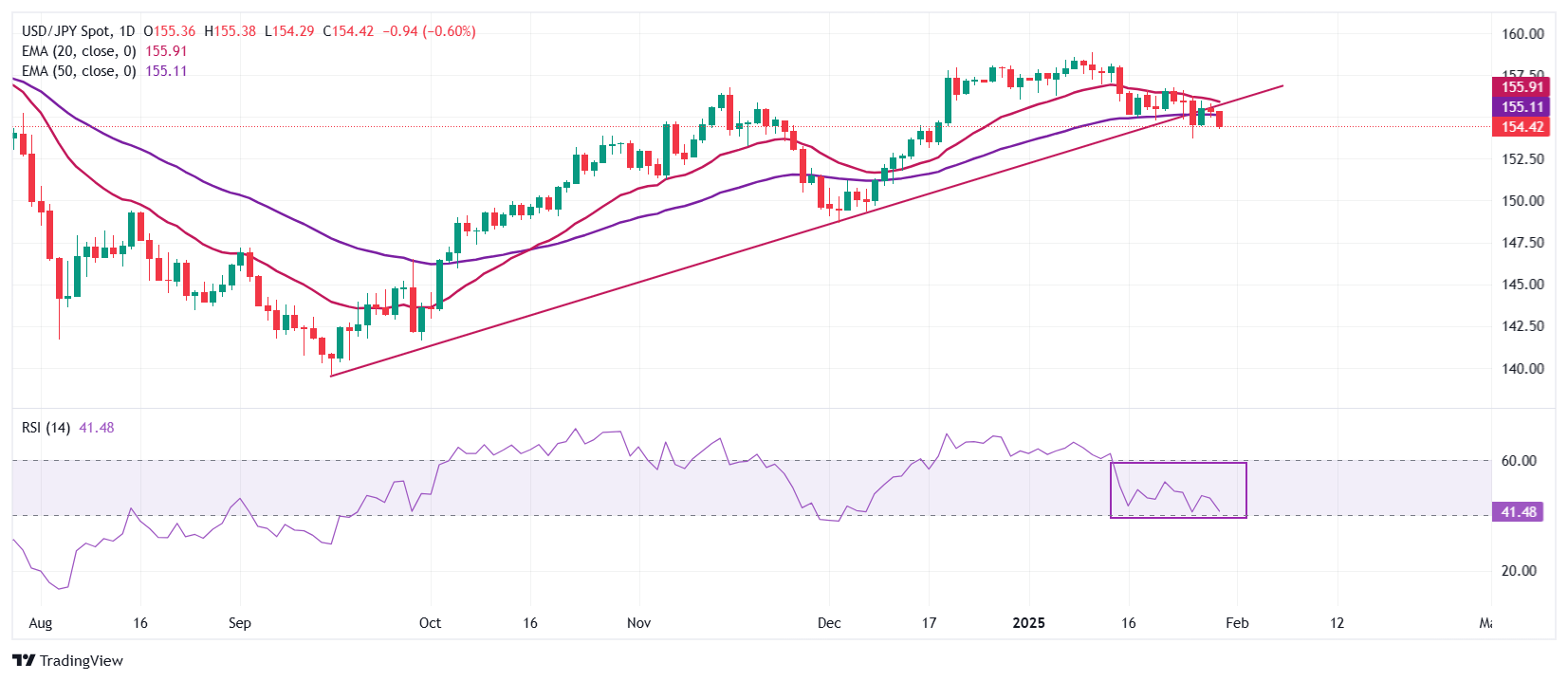- USD/JPY falls sharply to near 154.30 amid strong performance by the Japanese Yen across the board.
- Bloating BoJ hawkish bets have increased the Yen’s appeal.
- The Fed kept its borrowing rates steady in the range of 4.25%-4.50% on Wednesday.
The USD/JPY pair slumps to near 154.30 in Thursday’s European session. The asset weakens as the Japanese Yen (JPY) performs strongly across the board amid growing expectations that the Bank of Japan (BoJ) will continue hiking interest rates this year.
Japanese Yen PRICE Today
The table below shows the percentage change of Japanese Yen (JPY) against listed major currencies today. Japanese Yen was the strongest against the New Zealand Dollar.
| USD | EUR | GBP | JPY | CAD | AUD | NZD | CHF | |
|---|---|---|---|---|---|---|---|---|
| USD | 0.00% | -0.03% | -0.62% | -0.13% | 0.02% | 0.07% | 0.03% | |
| EUR | -0.01% | -0.04% | -0.59% | -0.15% | 0.00% | 0.06% | 0.02% | |
| GBP | 0.03% | 0.04% | -0.60% | -0.11% | 0.04% | 0.10% | 0.02% | |
| JPY | 0.62% | 0.59% | 0.60% | 0.47% | 0.63% | 0.65% | 0.60% | |
| CAD | 0.13% | 0.15% | 0.11% | -0.47% | 0.16% | 0.21% | 0.12% | |
| AUD | -0.02% | -0.01% | -0.04% | -0.63% | -0.16% | 0.06% | -0.01% | |
| NZD | -0.07% | -0.06% | -0.10% | -0.65% | -0.21% | -0.06% | -0.08% | |
| CHF | -0.03% | -0.02% | -0.02% | -0.60% | -0.12% | 0.01% | 0.08% |
The heat map shows percentage changes of major currencies against each other. The base currency is picked from the left column, while the quote currency is picked from the top row. For example, if you pick the Japanese Yen from the left column and move along the horizontal line to the US Dollar, the percentage change displayed in the box will represent JPY (base)/USD (quote).
Hawkish BoJ bets have accelerated on assumption that Japan's spring wage negotiations will result in strong hikes again this year. On Thursday, BoJ Deputy Governor Ryozo Himino also said that the central bank “will raise rates if economy and prices move in line with forecast”.
Meanwhile, the US Dollar (USD) trades sideways after the Federal Reserve’s (Fed) first monetary policy decision of the year in which it left interest rates unchanged in the range of 4.25%-4.50%, as expected. Fed Chair Jerome Powell guided that the central bank will resume the policy-easing cycle only when it sees some progress in disinflation towards the central bank’s target of 2% or some weakness in the labor market.
In Thursday’s session, investors will focus on the United States (US) Q4 Gross Domestic Product (GDP) data, which will be published at 13:30 GMT. On an annualized basis, the US economy is expected to have grown at a slower pace of 2.6%, compared to 3.1% growth seen in the third quarter of 2024.
USD/JPY trades below the upward-sloping trendline around 155.00, which is plotted from the September 13 low of 139.58 on a daily timeframe. The outlook of the asset has weakened as it trades below the 20- and 50-day Exponential Moving Averages (EMAs), which hovers around 155.90 and 155.10, respectively.
The 14-day Relative Strength Index (RSI) slides to near 40.00. A fresh bearish momentum would trigger if the RSI breaks below 40.00.
USD/JPY could see building of significant offers on a downside move below the January 27 low of 153.70, which would decline to near December 12 low of 151.80, followed by the December 11 low of 151.00.
On the contrary, an upside move above the January 23 high of 156.75 would drive the pair towards the January 15 high of 158.08 and the January 10 high of 158.88.
USD/JPY daily chart
(This story was corrected on January 30 at 12:19 GMT to say that hawkish BoJ bets have accelerated, not dovish bets, and that the pair would decline to near December 12 low of 151.80, not high.)
Japanese Yen FAQs
The Japanese Yen (JPY) is one of the world’s most traded currencies. Its value is broadly determined by the performance of the Japanese economy, but more specifically by the Bank of Japan’s policy, the differential between Japanese and US bond yields, or risk sentiment among traders, among other factors.
One of the Bank of Japan’s mandates is currency control, so its moves are key for the Yen. The BoJ has directly intervened in currency markets sometimes, generally to lower the value of the Yen, although it refrains from doing it often due to political concerns of its main trading partners. The BoJ ultra-loose monetary policy between 2013 and 2024 caused the Yen to depreciate against its main currency peers due to an increasing policy divergence between the Bank of Japan and other main central banks. More recently, the gradually unwinding of this ultra-loose policy has given some support to the Yen.
Over the last decade, the BoJ’s stance of sticking to ultra-loose monetary policy has led to a widening policy divergence with other central banks, particularly with the US Federal Reserve. This supported a widening of the differential between the 10-year US and Japanese bonds, which favored the US Dollar against the Japanese Yen. The BoJ decision in 2024 to gradually abandon the ultra-loose policy, coupled with interest-rate cuts in other major central banks, is narrowing this differential.
The Japanese Yen is often seen as a safe-haven investment. This means that in times of market stress, investors are more likely to put their money in the Japanese currency due to its supposed reliability and stability. Turbulent times are likely to strengthen the Yen’s value against other currencies seen as more risky to invest in.
Information on these pages contains forward-looking statements that involve risks and uncertainties. Markets and instruments profiled on this page are for informational purposes only and should not in any way come across as a recommendation to buy or sell in these assets. You should do your own thorough research before making any investment decisions. FXStreet does not in any way guarantee that this information is free from mistakes, errors, or material misstatements. It also does not guarantee that this information is of a timely nature. Investing in Open Markets involves a great deal of risk, including the loss of all or a portion of your investment, as well as emotional distress. All risks, losses and costs associated with investing, including total loss of principal, are your responsibility. The views and opinions expressed in this article are those of the authors and do not necessarily reflect the official policy or position of FXStreet nor its advertisers. The author will not be held responsible for information that is found at the end of links posted on this page.
If not otherwise explicitly mentioned in the body of the article, at the time of writing, the author has no position in any stock mentioned in this article and no business relationship with any company mentioned. The author has not received compensation for writing this article, other than from FXStreet.
FXStreet and the author do not provide personalized recommendations. The author makes no representations as to the accuracy, completeness, or suitability of this information. FXStreet and the author will not be liable for any errors, omissions or any losses, injuries or damages arising from this information and its display or use. Errors and omissions excepted.
The author and FXStreet are not registered investment advisors and nothing in this article is intended to be investment advice.
Recommended content
Editors’ Picks

EUR/USD retargets 1.0500 on extra Dollar weakness
The selling pressure around the US Dollar picks up pace and lifts EUR/USD to the area of two-day peaks near the 1.0480 level amid declining US and German yields.

Gold sets new record-high above $2,950
Gold retreats slightly but remains within a touching distance of the record-high it set above $2,950 in the European session on Thursday. Retreating US Treasury bond yields and the risk-averse market environment help XAU/USD hold its ground.

GBP/USD holds ground above 1.2600 after US data
GBP/USD stays in positive territory above 1.2600 on Thursday, supported by a sustained US Dollar weakness following the disappointing Jobless Claims data. The cautious market mood, however, seems to be limiting the pair's upside in the near term.

Bitcoin consolidation continues as market prepares for the next major move
Bitcoin has been consolidating between $94,000 and $100,000 since February 5. Glassnode reports weakening capital inflows and declining derivatives activity, with short-term holder accumulation resembling challenging market conditions.

Money market outlook 2025: Trends and dynamics in the Eurozone, US, and UK
We delve into the world of money market funds. Distinct dynamics are at play in the US, eurozone, and UK. In the US, repo rates are more attractive, and bills are expected to appreciate. It's also worth noting that the Fed might cut rates more than anticipated, similar to the UK. In the eurozone, unsecured rates remain elevated.

The Best brokers to trade EUR/USD
SPONSORED Discover the top brokers for trading EUR/USD in 2025. Our list features brokers with competitive spreads, fast execution, and powerful platforms. Whether you're a beginner or an expert, find the right partner to navigate the dynamic Forex market.
